Since moving on board, choosing to live and sail full-time, we both agree that we have never eaten better in our lives, despite being two foodies from London. The test of a gourmet galley is how to cope with the challenge of a long sea crossing and now, with two oceans under our belts, we feel as though we’ve really learnt the ropes.
A good technique for organising fresh food onboard is to store it carefully. String hammocks and hanging items helps keep them aired, plus it’s easy to check which ones are ripening fast and need eating first. Some fruit and veg does well stacked in trays, crates or boxes and stored in the coolest part of the boat. Bunches of bananas hang quite beautifully from grab-rails but we always try to separate them out, to stop them all ripening at once.
You can be savvy and choose vegetables that will last longer than others like cabbages, onions, potatoes, garlic and beetroot. Plus these are happy to be stored in darker places, so our saloon seating was stuffed with them. Although we still checked them with an almost religious fanaticism. Then there are the most robust and hardy ones of them all: the pumpkins, squashes, coconuts and limes, which will see you through to the end of almost any voyage. Even having eggs on long passages is straightforward if you buy them unrefrigerated and as fresh as possible. We keep them in normal cardboard containers or in a plastic one and stored somewhere cool, where they will feel minimal movement in even big seas. No smearing with Vaseline or other magic needed.
Another great trick is to carry a lot of dried fruit. Before our Pacific crossing we borrowed a vacuum sealer from a friend and made up packs of dried mango, papaya and figs to liven up our food choices on board. This also worked well for cereal and coffee and we even had time to vacuum pack any meat in our fridge before leaving which helped to prolong its life. We were always cautioned by other sailors to have tinned fruit and veg in stock for long offshore passages, but we’ve never used them. Even in the hottest climates you can still eat fresh stuff, which is far better and has a much nicer flavour. Beans, pulses, lentils and chickpeas, however, are great in tins; providing a brilliant source of protein and hugely reducing the cooking time needed to cook up the dried ones.
Making bread at sea sounds like something only undertaken by the coolest, most accomplished and expert mariners. However, it’s easier than you might guess and is something that you don’t have to be any kind of domestic goddess to do well – as even I can do it. It’s only flour, water, salt and yeast. However, there will always be hiccups when the dough doesn’t rise or the timing doesn’t quite work but don’t despair as half-made dough can always be turned into pizza bases or flatbreads.
One of the greatest joys of sailing and exploring so many different countries is the opportunity to eat both locally and seasonally. After we had sailed for 9 months in the south Pacific we were thrilled to find items like broccoli and apples were cheap and readily available in New Zealand, as both were hugely overpriced and imported in all the island groups that we’d been visiting en route. We also arrived there at the start of strawberry season and witnessed the transition of the year at the famers’ markets through the cycle of blueberries, sweetcorn and passionfruit that accompanied the changes in climate.
Like anyone else, the average cruiser will undoubtedly have times where they simply cannot be bothered to cook and it’s here that the economy of local food really comes into it’s own. We always gravitate towards street food rather than places aimed at tourists. Some of our most memorable and enjoyable meals were had this way: fried fish in Morocco; blue-corn tortillas in El Salvador; spicy rotis in Fiji; cheap and delicious taco stands all across Mexico; pistachio, aniseed and cream cakes in Portugal; crispy fried chicken in the East Caribbean islands and steak frites all across French Polynesia. Yum!
After all, we are the lucky ones who can take our homes with us, even to the furthest reaches of the globe. So why shouldn’t the food that we eat on board be just as much of an adventure too?
